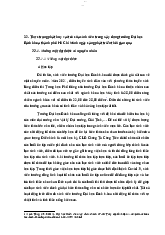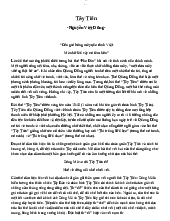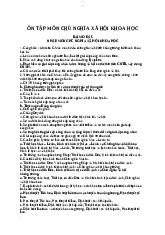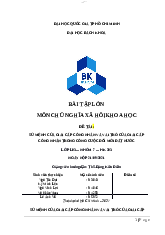





Preview text:
lOMoARcPSD|47206521 lOMoARcPSD|47206521
Storms, with heavy rainfall and strong winds, can significantly impact landslide and
flood issues, especially in vulnerable areas. Some descriptions of the effects of storms: Landslides:
Increased water content: Heavy rainfall in a short period can saturate the soil,
making it heavier and more prone to landslides. Rainwater can also infiltrate
cracks and voids in the soil, reducing the stability of slopes.
Reduced cohesion: Abundant water can decrease the adhesion between soil
particles, making them easier to be washed away by runoff.
Erosion: Heavy rain can cause surface erosion, reducing the slope's resistance to sliding.
Terrain changes: Floods caused by storms can alter the terrain, creating new
slopes or increasing the steepness of existing ones, making them more susceptible to landslides. Flooding:
Rising water levels: Heavy rainfall in a short time can cause rivers and streams to
quickly overflow, flooding riverbanks and low-lying areas.
Overloaded drainage systems: Urban drainage systems may become overloaded
due to heavy rainfall, leading to street and house flooding.
Storm surges: Coastal storms can create large waves, causing coastal erosion,
destroying homes and infrastructure, and pushing seawater inland.
High tides: High tides combined with heavy rainfall from storms can exacerbate flooding in coastal areas.
Additionally, storms can trigger other hazardous weather phenomena such as tornadoes
and lightning, further worsening flooding and landslide conditions.
Rainfall Distribution in Vietnam: A Spatial and Temporal Analysis
Rainfall in Vietnam exhibits significant variations across both spatial and temporal
dimensions, characterized by the amount of rainfall, its timing, and the various forms it takes. Rainfall Quantity:
Northern Region: Annual rainfall averages high (1500-2000mm), primarily
concentrated during the summer months (June to August). Rainfall gradually decreases from north to south. lOMoARcPSD|47206521
Rainfall in Vietnam exhibits significant variations across both spatial and temporal dimensions,
characterized by the amount of rainfall, its timing, and the various forms it takes.Central Region:
Annual rainfall is generally high (around 2000mm) but unevenly distributed: o
North-Central Coast: The rainy season extends from September to November, with
substantial rainfal due to typhoon influences. o
South-Central Coast: The rainy season is shorter (September to October) and receives less rainfal . o
Tay Nguyen Uplands: The rainy season persists from May to October, bringing abundant rainfall.
Southern Region: Annual rainfall averages high (around 1500mm), concentrated mainly
during the rainy season (May to October). Rainfall decreases gradually from east to west. Rainfall Timing:
Northern Region: The rainy season peaks in June, July, and August.
Central Region: Rainy season: o
North-Central Coast: The rainy season spans from September to November. o
South-Central Coast: The rainy season occurs from September to October. o
Tay Nguyen Uplands: The rainy season persists from May to October.
Southern Region: The rainy season is concentrated from May to October. Rainfall Forms:
Convectional Rain: Occurs throughout the regions, typically during summer
afternoons, characterized by sudden bursts and heavy downpours.
Drizzle: Prevalent in the northern region during winter, featuring tiny, persistent raindrops.
Thunderstorms: Occur in all regions, often accompanied by lightning, strong winds,
and potentially leading to floods.
Snowfall: Extremely rare, confined to high mountain peaks in the northern region. lOMoARcPSD|47206521
Rainfall in Vietnam exhibits significant variations across both spatial and temporal
dimensions, characterized by the amount of rainfall, its timing, and the various forms it takes. Rainfall Quantity:
Northern Region: Annual rainfall averages high (1500-2000mm), primarily
concentrated during the summer months (June to August). Rainfall gradually decreases from north to south.
Central Region: Annual rainfall is generally high (around 2000mm) but unevenly distributed: o
North-Central Coast: The rainy season extends from September to
November, with substantial rainfall due to typhoon influences. South- o
Central Coast: The rainy season is shorter (September to October) and receives less rainfall. o
Tay Nguyen Uplands: The rainy season persists from May to October, bringing abundant rainfall.
Southern Region: Annual rainfall averages high (around 1500mm), concentrated
mainly during the rainy season (May to October). Rainfall decreases gradually from east to west. Rainfall Timing:
Northern Region: The rainy season peaks in June, July, and August.
Central Region: Rainy season: o
North-Central Coast: The rainy season spans from September to November. o
South-Central Coast: The rainy season occurs from September to October. o
Tay Nguyen Uplands: The rainy season persists from May to October.
Southern Region: The rainy season is concentrated from May to October. Rainfall Forms:
Convectional Rain: Occurs throughout the regions, typically during summer
afternoons, characterized by sudden bursts and heavy downpours.
Drizzle: Prevalent in the northern region during winter, featuring tiny, persistent raindrops. lOMoARcPSD|47206521
Thunderstorms: Occur in all regions, often accompanied by lightning, strong
winds, and potentially leading to floods.
Snowfall: Extremely rare, confined to high mountain peaks in the northern region.
Vietnam is one of the countries heavily affected by tropical cyclones. Here are some
characteristics of cyclones in Vietnam:
Number of typhoons per year:
On average, 3-4 typhoons directly affect Vietnam each year.
The number of typhoons can vary from 1-13 per year, depending on climate change.
The typhoon season usually starts in June and lasts until November, with the peak
months being July, August, and September. Typhoon intensity:
Typhoons are classified according to the strongest 1-minute wind speed near the center of the storm:
o Tropical depression: 39 - 62 km/h. o Weak typhoon: 63 - 117 km/h.
o Moderate typhoon: 118 - 177 km/h.
o Strong typhoon: 178 - 217 km/h.
o Very strong typhoon: 218 - 261 km/h.
o Super typhoon: Over 261 km/h.
Landfall location: Typhoons typically make landfall in the central coastal regions, from Quang Ngai to Ninh Thuan. Other characteristics:
Typhoons move in a northwest - southeast direction.
Typhoons cause extensive damage to life and property due to strong winds, heavy
rain, flooding, high waves, and landslides.
Typhoons also affect the fishing, agriculture, transportation, and tourism industries. lOMoARcPSD|47206521
Trái Đất là hành tinh duy nhất trong hệ Mặt Trời được biết đến là có sự sống, và điều
này phụ thuộc vào sự tương tác phức tạp giữa bốn quyển chính: địa quyển, sinh quyển,
thủy quyển và khí quyển. Mỗi quyển đóng vai trò thiết yếu trong việc duy trì các điều
kiện cần thiết cho sự sống, và sự thay đổi ở bất kỳ quyển nào cũng có thể ảnh hưởng
đáng kể đến những quyển khác.
Hiểu biết về sự tương tác giữa các quyển này là điều cần thiết để giải quyết các vấn đề
môi trường cấp bách hiện nay. Do đó, việc nghiên cứu và khảo sát các quyển này
đóng vai trò quan trọng trong việc bảo vệ môi trường và phát triển bền vững.
Báo cáo này ghi chép lại chuyến thực địa được thực hiện nhằm mục đích nghiên cứu
và khảo sát các khía cạnh của địa quyển, sinh quyển, thủy quyển và khí quyển, tài
nguyên tại 10 điểm lộ.
Báo cáo này hy vọng sẽ góp phần nâng cao nhận thức về tầm quan trọng của việc bảo
vệ môi trường và khuyến khích các hành động thiết thực để xây dựng một tương lai bền vững cho Trái Đất. lOMoARcPSD|47206521
Earth is the only planet in the Solar System known to support life, and this is dependent
on the complex interaction between four main spheres: the geosphere, biosphere,
hydrosphere, and atmosphere. Each sphere plays an essential role in maintaining the
conditions necessary for life, and changes in any one sphere can have a significant impact on the others.
Understanding the interactions between these spheres is essential to addressing today's
pressing environmental problems. Therefore, the study and survey of these spheres play
a crucial role in environmental protection and sustainable development.
This report documents a field trip conducted for the purpose of researching and
surveying aspects of the geosphere, biosphere, hydrosphere, and atmosphere, and resources at 10 sites.
This report hopes to raise awareness of the importance of environmental protection and
encourage practical actions to build a sustainable future for Earth.




